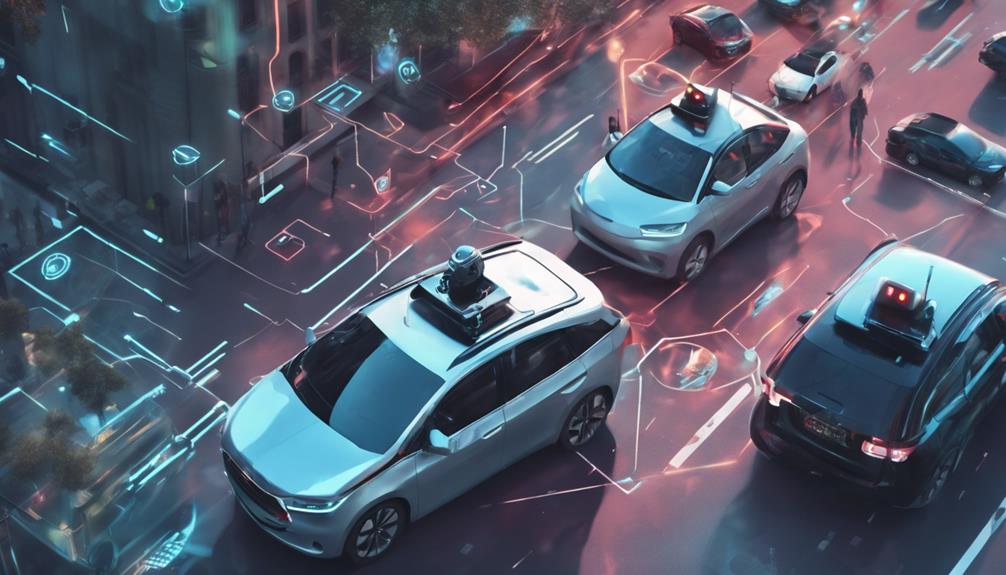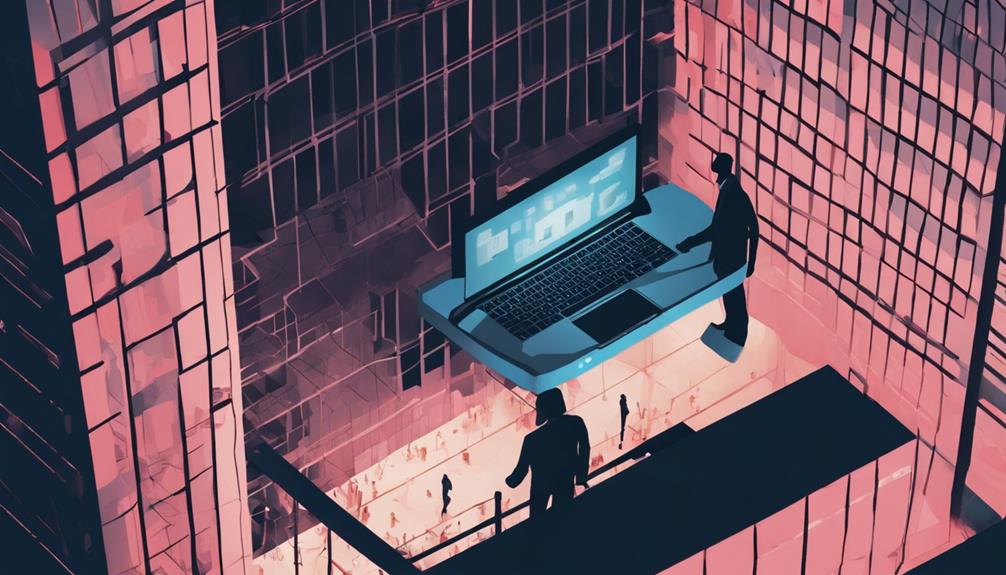AI presents significant risks in cybersecurity, from data breaches to biased decisions. It automates attacks, exploiting vulnerabilities efficiently, challenging traditional defenses. AI-driven malware evolves, complicating detection efforts. Malicious AI threatens physical safety, manipulating critical systems. Privacy is at risk from AI vulnerabilities, requiring strict access control. Protecting AI models is essential to prevent theft and maintain competitiveness. Impersonation threats deceive users through social engineering tactics. Sophisticated AI attacks tailor phishing campaigns, evade security tools, and create deepfake content for fraud. Understanding these risks is important to safeguard against evolving cyber threats and maintain robust cybersecurity measures.
Key Takeaways
- AI in cybersecurity revolutionizes defenses with machine learning.
- AI threats encompass data breaches and malicious activities.
- Automated attacks exploit vulnerabilities at scale.
- AI-driven malware evolves in real-time, challenging detection.
- AI poses risks to physical safety and privacy vulnerabilities.
AI in Cybersecurity Overview
Utilizing advanced technologies such as machine learning and deep learning, AI plays a pivotal role in revolutionizing cybersecurity practices to enhance threat detection and response mechanisms.
AI technologies are instrumental in bolstering cybersecurity defenses by enabling intelligent systems to detect and prevent cyber threats more effectively.
Tasks like anomaly detection, malware analysis, and network security benefit greatly from AI's ability to mimic human intelligence for problem-solving in the domain of cybersecurity.
The application of AI continues to evolve, with a specific focus on enhancing warning and response capabilities to mitigate cyber risks effectively.
Risks of AI Cyber Threats

The emergence of AI cyber threats poses significant risks to organizations and individuals alike, encompassing data breaches, adversarial attacks, and vulnerabilities in AI-generated code. These risks threaten the security of sensitive information, leading to potential malicious activities by threat actors.
Adversaries can exploit AI models to create fraudulent content, causing reputation damage and privacy breaches. Additionally, AI systems are susceptible to manipulation, coercion, and unauthorized access, heightening the potential for cyberattacks to occur.
Moreover, the risks associated with AI-generated outputs extend to the possibility of incorrect or biased decisions, which could have severe consequences, especially in critical systems like medical diagnostics. Privacy concerns further compound these risks, as data sharing within AI platforms may expose personal information to unauthorized access and misuse, compromising individuals' privacy and security.
Understanding these risks is vital for implementing robust security measures to safeguard against the evolving landscape of AI cyber threats.
Cyberattack Optimization Dangers

Cyberattack optimization through AI poses significant risks in today's cybersecurity landscape. Attack automation using artificial intelligence can streamline malicious activities, increasing the speed and scale of threats.
Moreover, AI-driven vulnerabilities and targeted threat detection mechanisms are vital areas that need attention to bolster defenses against evolving cyber threats.
Attack Automation Risks
Moreover, automating attacks with AI technology poses significant dangers in optimizing cyber threats, enhancing their efficiency and impact.
AI-driven cyberattack tools enable automated attacks that can rapidly evolve and adapt, making them formidable adversaries in the digital landscape. These automated attacks have the capability to target vulnerabilities at a large scale, potentially causing widespread damage and data breaches.
The use of AI in cyber threats allows malicious actors to exploit security system weaknesses with increased speed and accuracy, heightening the risk of successful cyber intrusions.
Moreover, the automation of cyber threats through AI escalates the speed and sophistication of attacks, challenging traditional defense mechanisms to keep pace with the evolving threat landscape.
As a result, organizations need to bolster their cybersecurity measures continually to defend against these advanced AI-driven automated attacks and safeguard their sensitive information from potential breaches.
AI-Driven Vulnerabilities
AI-driven vulnerabilities heighten the risk of cyberattacks by enabling threat actors to enhance their capabilities through intelligent systems. Adversaries leverage AI to automate and scale attacks, reducing the complexity and cost barriers associated with cybercriminal activities. This trend poses significant dangers to organizations as it allows threat actors to conduct more sophisticated and targeted cyberattacks with greater efficiency.
The use of AI in cyberattacks also enables the creation of more convincing social engineering tactics, such as personalized phishing campaigns, which can deceive even vigilant individuals. Additionally, the rise of deepfake technology, powered by AI, presents a growing risk by enabling malicious actors to manipulate audio and video content for fraudulent purposes, further complicating cybersecurity efforts.
As AI models continue to evolve, it is essential for cybersecurity professionals to stay ahead of these advancements to effectively defend against emerging cyber threats.
Targeted Threat Detection
Effectively detecting targeted threats in cybersecurity requires a proactive and adaptive approach to counter the evolving tactics of AI-enhanced cyber attackers. As cyberattackers optimize their strategies using AI, traditional security tools can struggle to keep pace with these advanced threats.
AI-powered cyber threats have the capability to adapt rapidly, exploiting vulnerabilities in networks and systems with efficiency and precision. This reality underscores the critical importance of targeted threat detection in cybersecurity.
To effectively combat these sophisticated threats, organizations must invest in advanced detection capabilities that can identify and respond to AI-driven cyberattacks in real-time. By understanding the risks associated with AI-powered threats, cybersecurity professionals can develop robust defense strategies that prioritize targeted threat detection as a key pillar of their security posture.
Embracing innovative technologies and proactive approaches is essential to staying ahead of cyber attackers leveraging AI for malicious purposes. By enhancing targeted threat detection capabilities, organizations can better safeguard their digital assets and mitigate the risks posed by evolving cybersecurity threats.
Automated Malware Risks

Automated malware presents a pressing concern in cybersecurity due to its ability to rapidly create and distribute malicious software. AI-powered tools enable the generation of sophisticated malware variants that can evade traditional security measures, posing significant challenges for cybersecurity professionals.
As the threat landscape evolves, detecting and mitigating these AI-enhanced attacks becomes increasingly complex, emphasizing the need for advanced solutions in real-time detection and prevention strategies.
Malware Detection Challenges
Detecting and mitigating automated malware poses a significant challenge in the field of cybersecurity due to its ability to evade traditional detection methods by leveraging AI algorithms. AI-powered malware presents a sophisticated threat landscape, making it essential for cybersecurity professionals to implement advanced techniques for effective detection and response.
To navigate these challenges effectively, consider the following:
- Behavioral Analysis: Utilize behavioral analysis techniques to identify malware that displays unusual patterns or behaviors, enabling proactive threat detection.
- Polymorphic Malware: Be aware of the evolving nature of malware, especially polymorphic variants that change their code to evade detection, necessitating dynamic detection methods.
- Adaptive Security Measures: Implement adaptive security measures that can evolve in response to AI-powered malware's ability to adapt, ensuring robust protection.
- Continuous Monitoring: Regularly monitor and update AI-based malware detection systems to stay ahead of emerging threats and enhance overall cybersecurity posture.
Ai-Powered Attack Tactics
The proliferation of AI-powered attack tactics in the form of automated malware poses a formidable challenge to modern cybersecurity defenses. Malicious actors utilize AI models to create sophisticated malware that can adapt and evolve rapidly, making it harder for traditional security measures to detect and mitigate these threats effectively.
Machine learning algorithms enable cybercriminals to generate new variants of malware autonomously, allowing for faster propagation and increased evasion of detection mechanisms. This results in targeted attacks on vulnerable systems, amplifying the impact on organizations and individuals alike.
AI-driven malware's ability to adjust in real-time to security measures complicates threat detection and incident response efforts. Cyber attackers leverage AI to enhance the speed, scale, and stealth of their malware campaigns, emphasizing the critical need for robust cybersecurity strategies and all-encompassing defense mechanisms to counter these evolving threats effectively.
Organizations must stay vigilant and continuously update their security protocols to combat the escalating risk posed by automated malware.
Evolving Threat Landscape
With the relentless advancement of technology, the threat landscape is continuously evolving, particularly in the domain of automated malware risks. As cyber threats become more sophisticated, organizations must be vigilant in understanding the risks associated with AI-driven malware.
Consider the following key points:
- Threat actors: Cybercriminals are utilizing AI to automate the creation of malware, enabling them to launch attacks at scale and with increased speed.
- Vulnerabilities in AI: The very technology designed to enhance security can also be exploited by threat actors to create intelligent malware that can evade traditional defenses.
- Important use: It is essential for organizations to implement ethical guidelines and best practices when leveraging AI in cybersecurity to prevent unintended consequences.
- Impact on security measures: AI-powered malware can adapt in real-time, posing challenges for detection and mitigation efforts.
Physical Safety Concerns

AI poses tangible threats to cybersecurity that transcend the digital domain, encompassing significant physical safety concerns. Malicious AI applications have the capability to manipulate critical infrastructure such as autonomous vehicles, industrial machinery, and essential systems like power grids, transportation networks, and healthcare facilities.
The potential risks associated with AI-driven attacks on physical infrastructure are alarming, as they could result in catastrophic consequences and pose a direct threat to human lives. Ensuring the security of AI systems against these physical safety threats is crucial in preventing real-world disasters and safeguarding public safety.
As technology continues to advance, the need for robust cybersecurity measures that address both digital vulnerabilities and physical safety concerns becomes increasingly imperative. By staying vigilant and implementing proactive security protocols, organizations can mitigate the risks posed by malicious AI applications and protect vital infrastructure from potential harm.
Prioritizing the protection of physical systems from AI-enabled cyber threats is essential for maintaining a secure and resilient society.
AI Privacy Vulnerabilities

Privacy vulnerabilities in AI systems often stem from challenges associated with data anonymization and consent management processes. These vulnerabilities can lead to various risks, including data breaches, exposure of sensitive data, and increased privacy risks for individuals.
To emphasize the importance of addressing these vulnerabilities effectively, consider the following points:
- Data Breaches: AI systems may be susceptible to breaches that compromise the confidentiality of personal information.
- Sensitive Data Exposure: The exposure of sensitive data through AI platforms can result in severe privacy violations.
- Privacy Risks: Detailed profiling and potential privacy breaches facilitated by AI systems pose significant risks to individuals.
- Third-Party Access: Challenges in managing third-party access to AI platforms can increase the likelihood of privacy breaches and unauthorized data usage.
Stealing AI Models Implications

When AI models are stolen, the consequences extend beyond mere data loss – they can hinder innovation and stifle progress.
The impact of stolen models goes beyond financial losses, reaching into the core of technological advancement and competitive landscapes.
Understanding these implications is vital for organizations to secure their AI assets and safeguard against potential setbacks in the ever-evolving digital landscape.
Model Theft Consequences
The repercussions of model theft in AI cybersecurity are significant, encompassing the compromise of sensitive algorithms and intellectual property. When AI models are stolen, the consequences can be dire for organizations.
Here are some key points to take into account:
- Unauthorized access to proprietary machine learning techniques can occur, jeopardizing the uniqueness of algorithms developed by a company.
- Competitive advantages may be lost as rival entities gain insights into confidential strategies and processes, impacting market positioning.
- Threat actors could exploit stolen AI models for nefarious purposes, using them to orchestrate sophisticated cyber attacks or produce counterfeit products.
- Loss of control over AI models through theft can lead to financial losses, reputational damage, and legal ramifications, affecting the overall stability and trust in an organization's operations.
Protecting against model theft is essential for maintaining the security and competitiveness of AI systems in today's digital landscape.
Impact on Innovation
Stealing AI models carries profound implications for innovation within organizations, posing significant threats to financial stability and intellectual property security. The theft of AI models not only results in financial losses but also opens the door to intellectual property theft, putting organizations at risk of losing their competitive edge. Additionally, cybercriminals can leverage stolen AI models to imitate legitimate behaviors, making it challenging to detect and prevent cyber risks effectively.
To visualize the impact of AI model theft on innovation, consider the following table:
| Implications of Theft of AI Models |
|---|
| Financial Losses |
| Intellectual Property Theft |
| Competitive Advantages for Cybercriminals |
| Sophisticated Targeted Attacks |
| Reputational Damage and Loss of Trust |
Protecting AI systems from theft is paramount to safeguarding innovation and intellectual property. Organizations must implement robust security measures to uphold the integrity and security of their AI models, thereby fostering a conducive environment for continuous innovation and advancement in cybersecurity technologies.
Data Manipulation Risks

Data manipulation risks in AI pose significant threats to the integrity and accuracy of cybersecurity measures. Adversaries exploit vulnerabilities in AI algorithms to manipulate data inputs, potentially leading to biased or incorrect outcomes. This manipulation can result in flawed decisions by AI systems, jeopardizing the security and reliability of cybersecurity measures.
Data poisoning attacks, a common tactic, involve malicious inputs that distort the learning process, impacting decision-making. To mitigate these risks effectively, organizations must implement robust data validation processes, guarantee secure data storage, and continuously monitor for anomalies.
Unauthorized alterations to datasets can compromise the integrity of AI models. Exploiting vulnerabilities in AI algorithms can lead to biased or incorrect outcomes. Flawed decisions by AI systems can compromise cybersecurity measures. Data poisoning attacks distort the learning process and impact decision-making.
Impersonation Threats

Impersonation threats in cybersecurity are a significant concern due to the potential for attackers to exploit vulnerabilities by pretending to be legitimate users or systems, resulting in unauthorized access and various detrimental consequences. Attackers leverage techniques such as social engineering, phishing emails, and domain spoofing to deceive individuals into disclosing sensitive information or performing actions that compromise security.
Email scams, where attackers impersonate executives or colleagues, are common forms of impersonation attacks that aim to trick recipients into transferring funds or sharing confidential data.
To combat impersonation threats, organizations can implement multi-factor authentication to add an extra layer of security beyond passwords. Additionally, regular user training on how to recognize phishing attempts and email filtering to detect suspicious emails can help mitigate the risks associated with impersonation attacks.
Sophisticated AI Attacks Impact

The increasing sophistication of AI-driven cyberattacks poses a significant challenge to traditional cybersecurity defenses. As threat actors harness the power of AI systems, particularly generative AI, the landscape of security threats evolves rapidly.
Here are four key impacts of these advanced AI attacks:
- Automated Phishing Campaigns: AI enables the automation of phishing emails, making them more convincing and tailored to deceive targets effectively.
- Enhanced Malware Creation: Threat actors use AI to develop sophisticated malware that can evade detection by traditional security tools.
- Social Engineering Advancements: AI empowers social engineering attacks by analyzing vast amounts of data to craft personalized and persuasive messages.
- Deepfake Risks: The use of deepfake technology poses a significant risk as it allows for the creation of highly realistic fraudulent content, enabling impersonation and spreading misinformation.
These advancements in AI-driven cyberattacks highlight the urgent need for organizations to enhance their cybersecurity strategies to combat these emerging threats effectively.
Frequently Asked Questions
What Are the Cybersecurity Risks of Using Ai?
Utilizing AI in cybersecurity introduces risks such as data breaches, adversarial attacks, and vulnerabilities in AI-generated code. These threats can compromise system integrity, lead to copyright violations, and impact brand reputation if exploited by cybercriminals.
How Can AI Be a Threat to Security?
AI can pose a threat to security through various means, such as data breaches, adversarial attacks, and vulnerabilities in AI-generated code. Understanding these risks is essential in developing robust cybersecurity measures to mitigate potential threats.
What Is the Main Challenge of Using AI in Cybersecurity?
The main challenge of using AI in cybersecurity lies in safeguarding AI models from adversarial attacks that can manipulate data inputs, deceive the system, and evade detection. Ensuring the security and integrity of AI algorithms is paramount.
What Are Ai-Enhanced Cyber Threats?
Traversing the intricate labyrinth of AI-enhanced cyber threats requires vigilance and adaptability. From leveraging machine learning for automated attacks to evading detection with human-like precision, these threats demand constant evolution in cybersecurity defenses.
Conclusion
To wrap up, it is essential for organizations to be aware of the risks associated with AI in cybersecurity. By understanding the potential dangers such as cyberattack optimization, automated malware, and data manipulation, they can better protect their systems and data.
Remember, knowledge is power, and staying informed about these threats will help mitigate the impact of sophisticated AI attacks. Stay vigilant and stay safe in the ever-evolving landscape of cybersecurity.









